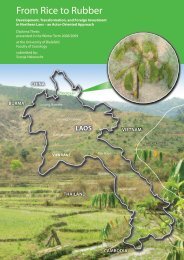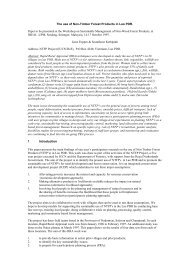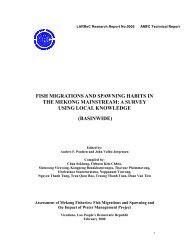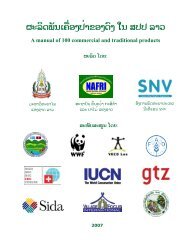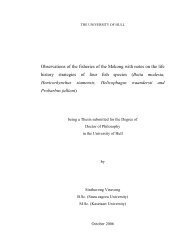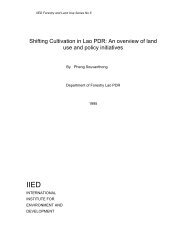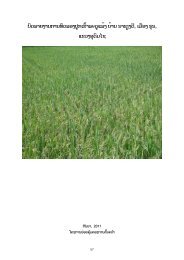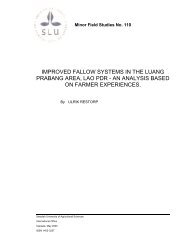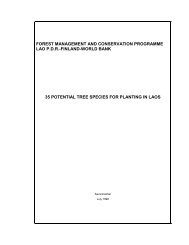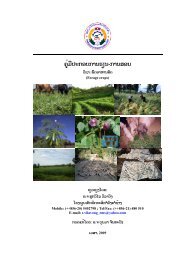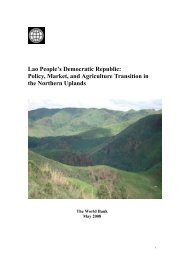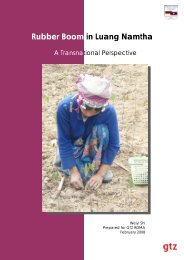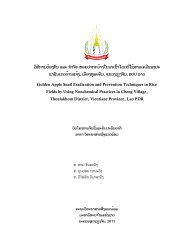Contract Farming in Lao PDR: Cases and Questions - LAD - nafri
Contract Farming in Lao PDR: Cases and Questions - LAD - nafri
Contract Farming in Lao PDR: Cases and Questions - LAD - nafri
Create successful ePaper yourself
Turn your PDF publications into a flip-book with our unique Google optimized e-Paper software.
• Given that this is a complex, immense <strong>and</strong> long-term<br />
challenge, what are the most urgent <strong>and</strong> important<br />
issues that need to be addressed <strong>in</strong> the immediate<br />
future?<br />
2.2 Are regulations clear, simple <strong>and</strong> accessible<br />
enough to promote contract farm<strong>in</strong>g?<br />
Probably not given the low-level of education of most<br />
farmers [Nam Ha; FUF]. They often f<strong>in</strong>d regulations difficult to<br />
underst<strong>and</strong> <strong>and</strong> follow. Awareness is not high. That may give<br />
traders or <strong>in</strong>vestors an advantage <strong>in</strong> negotiat<strong>in</strong>g contracts,<br />
even with better educated village heads [chillis]. There is still<br />
confusion <strong>and</strong> divergence among <strong>and</strong> between farmers,<br />
traders <strong>and</strong> officials over what constitutes contract farm<strong>in</strong>g<br />
<strong>in</strong> different prov<strong>in</strong>ces.<br />
Further questions:<br />
• How could regulations be more clearly written <strong>and</strong> their<br />
mean<strong>in</strong>g <strong>and</strong> <strong>in</strong>tention communicated rapidly to officials<br />
<strong>and</strong> the public?<br />
• Which agencies of the Government should be <strong>in</strong>volved?<br />
2.3 Is affordable credit easily available to all<br />
farmers who want to exp<strong>and</strong> production for<br />
contract production?<br />
Availability of cheap credit is patchy. Most farmers <strong>and</strong> even<br />
groups are not well received by banks. Some farmers prefer<br />
to borrow <strong>in</strong>dividually rather than as part of a group [sugar].<br />
In any case <strong>in</strong>terest rates from banks are high, around 15-20<br />
percent a year. Some farmers, especially where communities<br />
are strong or groups well established, can borrow small<br />
amounts from the group or trader aga<strong>in</strong>st <strong>in</strong>come from the<br />
crops be<strong>in</strong>g grown under contract [Nam Ha; chilli]. In some<br />
cases this is <strong>in</strong>terest free, <strong>in</strong> others rates can be usurious,<br />
especially when traders are lend<strong>in</strong>g [coffee]. The shortage of<br />
cheap, abundant credit leaves farmers at risk of fall<strong>in</strong>g <strong>in</strong>to<br />
debt traps or bondage, <strong>and</strong> reduces long-term prospects<br />
for rais<strong>in</strong>g <strong>in</strong>comes through <strong>in</strong>vestment <strong>in</strong> l<strong>and</strong>, irrigation,<br />
seeds, <strong>and</strong> equipment. Prospects for add<strong>in</strong>g value to crops,<br />
for example through dry<strong>in</strong>g or basic process<strong>in</strong>g, are dim<br />
when farmers, groups or communities cannot easily obta<strong>in</strong><br />
affordable.<br />
Further questions:<br />
• What solutions are there for the credit drought?<br />
• Should traders be encouraged to provide credit as<br />
part of contract farm<strong>in</strong>g, or does it make more sense<br />
to support microf<strong>in</strong>ance, sav<strong>in</strong>g schemes <strong>and</strong> revolv<strong>in</strong>g<br />
funds?<br />
2.4 Is transport of crops reliable, regular, fast <strong>and</strong><br />
cheap enough to nurture contract farm<strong>in</strong>g?<br />
Transport costs an average of 7.5 baht per ton for each<br />
kilometre <strong>in</strong> <strong>Lao</strong>s compared to 3.2 baht <strong>in</strong> Thail<strong>and</strong> (NAFES<br />
2006, 1.1). This is a barrier to markets which <strong>in</strong>creases costs<br />
reduc<strong>in</strong>g crops competitiveness. Farmers on the Bolaven<br />
f<strong>in</strong>d buy<strong>in</strong>g their own trucks works out cheaper than us<strong>in</strong>g<br />
transport services to take their cabbages to market. For<br />
many farmers <strong>in</strong> areas not yet served by surfaced roads<br />
costs be even higher <strong>and</strong> access to markets worse, even<br />
non-existent. Factors compounded by regulations hamper<strong>in</strong>g<br />
free movement of goods, excessive fees <strong>and</strong> adm<strong>in</strong>istration<br />
charges, <strong>in</strong>ter-regional transport fees <strong>and</strong> controls (NAFES<br />
2006, 1.1). The SEFCP ga<strong>in</strong>ed power <strong>and</strong> authority under<br />
decentralization <strong>in</strong>clud<strong>in</strong>g a monopoly on transfer of produce<br />
between prov<strong>in</strong>ces (NAFES 2006, 1.4.2). In Vietnam<br />
comprehensive <strong>and</strong> good quality transport <strong>in</strong>frastructure<br />
support<strong>in</strong>g efficient <strong>and</strong> competitive transport services has<br />
been identified as an important factor facilitat<strong>in</strong>g contract<br />
farm<strong>in</strong>g (W<strong>and</strong>schneider 2006).<br />
Further questions:<br />
• What policies could create an environment encourag<strong>in</strong>g<br />
better private transport services for farmers?<br />
• Should farmers – as <strong>in</strong>dividuals or as groups - be<br />
encouraged to buy their own trucks? Is this a wise<br />
decision or a poor <strong>in</strong>vestment <strong>in</strong> the long-run?<br />
2.5 Is transport across borders smooth enough to<br />
open up wider markets for contract farmers?<br />
M<strong>in</strong>istry of Commerce order 962 (13th October 2004)<br />
abolished import-export licenses <strong>and</strong> establish one-stop<br />
trade services at border checkpo<strong>in</strong>ts (Leebouapao 2005,<br />
p.83). Yet <strong>in</strong> Bokeo, for example, it seems middlemen<br />
traders still control some trade with Thail<strong>and</strong> add<strong>in</strong>g costs<br />
<strong>and</strong> constrict<strong>in</strong>g access to buyers <strong>and</strong> higher prices. Some<br />
farmers have formed groups, which have rights to trade<br />
directly, bypass<strong>in</strong>g the middlemen traders, after register<strong>in</strong>g<br />
with local authorities [corn]. While elsewhere trade, especially<br />
smaller quantities or higher value crops takes place <strong>in</strong>formally,<br />
which seems cheaper <strong>and</strong> more efficient [watermelons].<br />
Tariffs <strong>and</strong> quotas still hamper trade, for example restrict<strong>in</strong>g<br />
imports of <strong>Lao</strong>tian corn <strong>in</strong>to Ch<strong>in</strong>a. It is unclear how much<br />
progress has been made <strong>in</strong> practise towards lower<strong>in</strong>g or<br />
dismantl<strong>in</strong>g tariffs <strong>and</strong> quotas under Asean’s free trade area.<br />
Restrictions on transport vehicles cross<strong>in</strong>g borders rema<strong>in</strong>,<br />
add<strong>in</strong>g costs <strong>and</strong> wast<strong>in</strong>g time. However these seem likely to<br />
be overturned if Asean makes good on its plans by 2010.<br />
51



